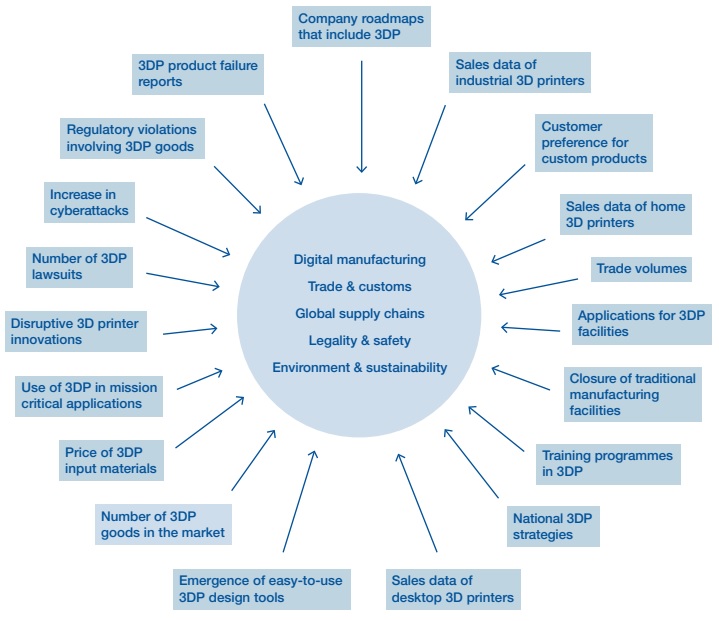3D printing is on the agenda for Davos 2020, cementing the technology as crucial for the new decade.
The World Economic Forum has published two new items that invite discussion. The first, “Would a digital border tax slow down adoption of 3D printing?”, is a continuation of the conversation around how to treat digital goods.
The second item is a new white paper, “3D Printing: A Guide for Decision Makers”.
Members of the World Trade Organization (WTO) agreed to maintain the current practice of not imposing customs duties on electronic transmissions in which such digital files and related services fall under. This is effective until the 12th Ministerial Conference (MC12) in Nur-Sultan, Kazakhstan, commencing this June.
Prior to this event, as well as the World Economic Forum (WEF) Annual Meeting in Davos, Switzerland, known as Davos 2020, later this month, the WEF have published a white paper entitled “3D Printing: A Guide for Decision-Makers.” This details the impact of extending, or removing the moratorium, on 3D printing and suggests how policies can be suited towards Industry 4.0. Davos 2020 will host industry leaders in discussions on shaping the global and regional.
More of the moratorium?
The moratorium on customs duties for electronic transmissions commenced in 1998 by WTO members and has since been rolled-over at every Ministerial Conference. According to the WEF whitepaper, the “debate continues regarding the moratorium on electronic transmissions in recent years.”
As stated by the Wohlers Report 2019, global additive manufacturing revenues have been rapidly growing at an average annual rate of 26.9% over the last 30 years. Yet the wider picture shows that 3D printed made up only 0.1% of 2018 global manufacturing
revenue. The WEF report adds that, “Some countries value the moratorium as an instrument to facilitate online and even offline trade.”
3D printing, according to the WEF, has the potential to decentralize manufacturing, reduce the need for inventory and change supply chains. The report also highlights the opportunity for more innovative products. For example, a World Bank study showing that hearing aids trade increased by 58% when 3D printing was used for its production.

Taxing new technologies
Conversely, the report describes how lifting the moratorium could promote nascent digital industries and enable the recuperation of a perceived loss of revenue. Safety and legislation are tackled.
The WEF report states, “With a high-performance 3D scanner, high-fidelity copies of physical products can be made and printed using a 3D printer. This could result in the proliferation of illegal copies of brand-name products. Thus, technology solutions will be needed to track 3D design files and other e-transmissions
crossing borders.”
In this case, countries will need a technology base to monitor digital flows, which, according to the WEF, could add new levels of friction costs for digital trade, ultimately causing hurdles for the adoption of additive manufacturing.
A level playing field
The WEF has deemed the following three areas worthy of exploring to determine the relevance of existing trade instruments concerning cross-border transmissions of 3D printing CAD files: Classification of the files as goods or services; Rules of Origin (RoO); and Customs revenues.
Following the discourse on electronic transmissions, it has also identified five areas that additive manufacturing has an impact on and presents leading indicators that policy-makers can monitor to encourage future adoption. The report adds, “Policies and regulations can serve as enablers for the legitimate development of [3D printing] while providing a level playing field and setting out a robust regulatory mandate and associated mechanisms against potential misuses.”
“Policy-makers can prepare themselves by developing regional and national strategies for encouraging healthy ecosystems for 3D printing; adjusting existing regulations/laws and/or developing new ones to prepare for potential unintended consequences; and incorporating leading indicators in periodic planning processes for trade, customs, IP regimes, and cybersecurity, among other areas.”

The WEF whitepaper was published in collaboration with Mitsubishi Chemical Holdings Corporation. The WEF Annual Meeting, Davos 2020, is set to take place from the 21-24th of January. The MC12 will be held from the 8-11th of June.
For updates on news and policies affecting additive manufacturing, subscribe to the 3D Printing Industry Newsletter, follow us on Twitter and like us on Facebook. Seeking a fresh start this year? Visit 3D Printing Jobs to find and post opportunities.
Featured image shows the mountains of Davos. Photo via WEF.

